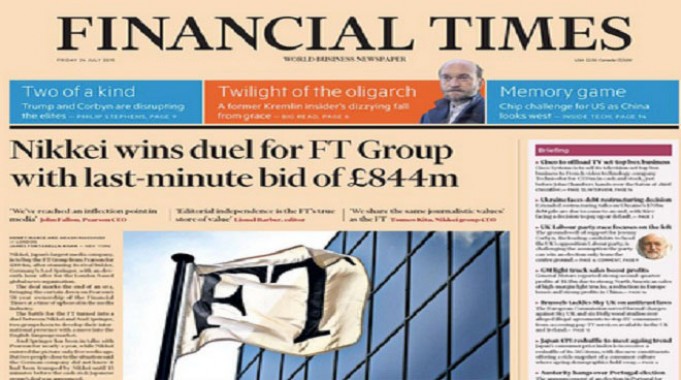It’s the subscribers, dummy
OUT OF PRINT
Binoo K John
M&A experts are trying to figure out the $1.3 billion dollar sale of the Financial Times (FT) to Japan’s media giant, the Nikkei group (the Tokyo stock exchange index is named after this group). The valuation is 35 times its operating income of $37 million on an annual revenue of $559 million).
The clearest explanation so far as to why Nikkei would splurge a billion on a newspaper which has brand value only in Europe is its digital subscriber base of 700,000 of which 500,000 are digital-only subscribers, according to an article in Linked in.com by Sajith Pai.
That is huge for any advertiser looking for the creamy layer of subscribers spread over Europe. FT has pioneered the metered payment model which means different rates for different requirements of reading, per week, per month and other such user friendly payment features. The other reason given is that it is a trophy property, or a super brand.
Also Nikkei will be hoping that the digital ad revenue will multiply drastically in the years to come because of its subscription base.
Does any big selling Indian daily have a market valuation? The big flaw here is that Indian newspapers are free digitally and hence do not have a digital subscription base. Also, only a few Indian newspapers have some sort of brand equity, to go behind a paywall.
Digital subscription may work if all the top newspapers come together, form a digital consortium, and start charging either for single papers or a bouquet of papers.
Digital subscription rates are very low with the New York Times now offering a week’s subscription for 49 cents. The basic thinking here is that if you don’t have a digital subscription base you are likely to become irrelevant. Advertising revenue may come but you have to compete with global biggies for even a small ad.
Now, even if I am reading The Guardian digital edition, I get an ad from the Indian ticketing site Makemytrip.com, because I had searched last week for some ticket rates on that site. The FT sale teaches us that a digital subscription base is the most valued component in a future valuation of a print newspaper. To build such a base looks impossible for Indian papers at the moment. The revenue for digital editions is minimal. The annual revenue for the online edition will be only worth two or three days of revenue for the print edition
*****

The Times of India and The Hindustan Times have a stated policy of accepting payment for social stories. But recently one suspects that the former went beyond this. In a globally released story last week about billionaire Yuri Milner forming a club of scientists and entrepreneurs to seek extraterrestrial life, The Times had a scoop on page one - an interview with the billionaire himself . Curiously, the extra terrestrial club had bought out a full page ad in the same issue. In such instances, many readers will wonder if there is a link between the full page ad, the nationally exclusive interview and a story on page one.
The ad , which no other Indian paper had (though all papers carried the story), would possibly have been linked to the exclusive interview otherwise the ad and the exclusive story would not have appeared on the same day purely by coincidence. In other words, it meant that the extra terrestrial club would have been asked to, or offered to buy, a full page if the story and interview were put on page one. The Times has a stated policy on selling editorial space but in this page-one hard news story, a disclaimer should have been put in place, just to clear suspicions.
*****
The Hindu’s new in-house designed Sunday magazine looks neat with a lot of breathing space. That earlier grim grey look has been done away with. What is most eye-catching is the gutter running vertically across every page dividing each page into vertical sections. I wonder if there is any larger purpose in that huge gutter on which the page slug is printed. Since there is white space on top couldn’t the page slug have come there?
There are two major purposes for a redesign. One is cosmetic to keep up with the times and the other is to change the content concept. Sadly in this inaugural issue, there is no indication of a new content concept. The columnists are the same, the articles are the same, and the use of photography is the same.
The lead heading with a pseudo-intellectual slant “Utopian chimeras of the future” completely put me off . Two words in the five word heading mean the same and ‘utopia’ cannot belong to the past in any way. Also, the Hindu magazine, like many other newspaper supplements, has a habit of filling up pages with articles from a bank which is a lazy way of bringing out a magazine. All articles, even travel, must have a newsy hook. A story which was banked or archived last week cannot suddenly become valuable this week.
*****
The Indian Express is the best reported newspaper in the country. Exclusives by senior reporters fill up any day’s edition. But that is no excuse for the desk to come out with this page one caption on July 27 under a single column picture:” The IAS couple had futilelysought toilets in Delhi’s CP”, coupled with an equally terrible heading: “Hunt for a public toilet leads to app, low-down on all.” The sub editor who handled the copy seems to have been pissed off.







